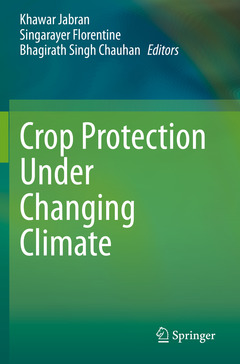Description
Crop Protection Under Changing Climate, 1st ed. 2020
Coordinators: Jabran Khawar, Florentine Singarayer, Chauhan Bhagirath Singh
Language: English
Subjects for Crop Protection Under Changing Climate:
Crop Protection Under Changing Climate
Publication date: 08-2021
204 p. · 15.5x23.5 cm · Paperback
Publication date: 08-2021
204 p. · 15.5x23.5 cm · Paperback
Crop Protection under Changing Climate
Publication date: 08-2020
204 p. · 15.5x23.5 cm · Hardback
Publication date: 08-2020
204 p. · 15.5x23.5 cm · Hardback
Description
/li>Contents
/li>Biography
/li>Comment
/li>
This book addresses the impact of important climatic changes on plant pests (including weeds, diseases and insect pests), and their interactions with crop plants. Anthropogenic activities have seriously impacted the global climate. As a result, carbon dioxide (CO2) and temperature levels of the earth are on a continuous rise. The global temperature is expected to increase by a 3°C or more by the end of this century. The CO2 concentration was below 300 parts per million (ppm) before the start of the industrial era; however, recently it has exceeded 400 ppm. This is highest ever in human history. Other than global warming and elevated CO2 concentrations, anthropogenic activities have also disturbed the global water cycle, ultimately, impacting the quantity and distribution of rainfall. This has resulted in drought conditions in many parts of the world.
Global warming, elevated CO2 concentration and drought are considered the most important recent climatic changes that are impacting global ecosystems and human societies. Among other impacts, the effects of climatic changes on pests, pest-crop interactions and pest control are important with relevance to global food security, and hence require immediate attention by plant scientists. This book discusses innovative and the most effective pest control methods under an environment of changing climate and elaborates on the impact of drought on plant pests and their control.
1. Introduction—implications of climate change for pests expansion and crop protection.- 2. Herbicide metabolism, weed growth, competition and control under changing climate.- 3. Climate change and invasive weeds.- 4. Impact of climate change on plant diseases and their management.- 5. Influence of climate change on insect pests and their management.- 6. Crop protection under drought stress.- 7. Impact of climate change on crop yields and quality.- 8. Impact of global warming on society and environment; issues and solutions.
Khawar Jabran is working as Assistant Professor in Nigde Omer Halisdemir University where he is leading the discipline of weed science. He has published more than 100 research publications as research articles, review papers, books and book chapters etc.
Professor Singarayer Florentine is a restoration and invasive species ecologist, with over 20 years of experience in research and higher education teaching in Australia. Prof. Florentine has published just over 100 refereed papers in the highest globally ranked journals in his field.
Bhagirath Chauhan, Weed Team Leader at the University of Queensland, leads an applied Weed Science and Management Program focused on field crop weed issues in the northern region of Australia. He has more than 300 publications, including books, book chapters and journal articles. He is editors of several journals
Elaborates the impact of recent global climatic changes on invasive and agricultural weeds, and their control Explains the impact of drought stress on crops, weeds and crop-weed interactions as well as weed control under drought conditions Highlights insect, pests, and disease control under changing climate, particularly elevated CO2 and global warming Explains the impact of climatic changes on the quality of agricultural products Features colored photos, which aide in understanding the text
© 2024 LAVOISIER S.A.S.




